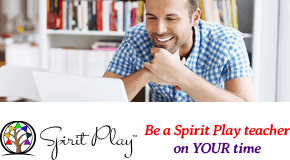Spirit Play
Looking for a method of Unitarian Universalist Religious Education programming that translated into developing a UU identity or a spiritual foundation for the children in the classroom, Rev. Ralph Roberts, Beverly Leute Bruce, and Rev. Dr. Nita Penfold (who was Spirit Play's Director for fifteen years) created Spirit Play.
We see the purpose of religious education as helping children in living into their own answers to the existential questions, as: Where did we come from? What are we doing here? What is our purpose? How do we choose to live our lives? What are our gifts? How do we use them? What happens when we die? Why do we die? Why are we lonely and sad sometimes?
We use the Montessori approach and Berryman's morning-as-worship approach for the structure of the morning. As in Montessori, the key elements are the classroom environment and the teachers. These elements free the children to work at their own pace on their own issues. In a typical Spirit Play morning:
- The Doorkeeper helps the children get ready to enter the classroom.
- The Storyteller leads the circle in the story of the day, followed by wondering.
- Children choose an art response or to use a story previously heard, helped by the Doorkeeper.
- Children clean-up, followed by a feast (snack) with the Storyteller and Doorkeeper.
- Leave-taking is a formal process of saying goodbye to the Storyteller and Doorkeeper.
Stories
Stories have been developed in the following categories using current children’s literature, myths, and religious stories that cover answers from various sources to the existential questions above. Each set of stories is color-coded or symbol-coded to the shelf for easy access and return.
- Unitarian Universalist Focus: Lessons pertaining to our central story of agreeing to live in the community and right relationship, including our central symbol, the Flaming Chalice, church history, UU history and UU figures.
- Promises: Lesson pertaining to our principles and stories illustrating each principle.
- Sources: Lessons pertaining to the sources of our principles and our faith, including Judeo-Christian stories.
- Stories of the Mystery: Stories relating to the Mystery that some people call God.
- Beginnings and Endings: Stories from all cultures and science telling of our beginnings and what might happen when we die, including concepts of heaven and hell, and reincarnation. These shelves will include materials on the Universe Story and the story of Earth.
- Sacred Places: Cards of sacred places from around the world, a finger labyrinth, and a basket of blocks to use in creating sacred spaces.
- Heroes and Heroines: People who we admire who relate to our sources such as Martin Luther King, Jr., Gandhi, and Mother Teresa, etc.
Spirit Play Introductory Lessons are available for purchase. See Materials for Sale link above. Currently, the complete set of stories and materials is only available with training.
Classroom Elements
In addition to the stories, a Spirit Play classroom has the following elements:
- Art Shelves: Contains materials for art responses including paint, clay, paper, crayons, markers, glue sticks, templates for U.U. and source symbols, and easels.
- Prayer Boxes: Contain ways in which people pray, i.e. using body prayer, beads, written prayers, etc. Also, those containing ways to be spiritual. Yoga Cards, a Buddha Board, and a Zen Garden.
- Church Corner: Model your sanctuary space with an altar table, lectern, and those materials needed for ceremonies at your church including child dedications, coming of age, marriage or union, memorial services, flower communion, water ceremony, etc. A basket with altar cloths, extra chalices, vases, and flowers can also be available to change the altar as a work choice.
- Cleaning Supplies Shelf and Snack Preparation Shelf: Child-size materials for clean-up and snack preparation. There is also a hand-washing station if there is no sink, and a station for clean-up from painting.



